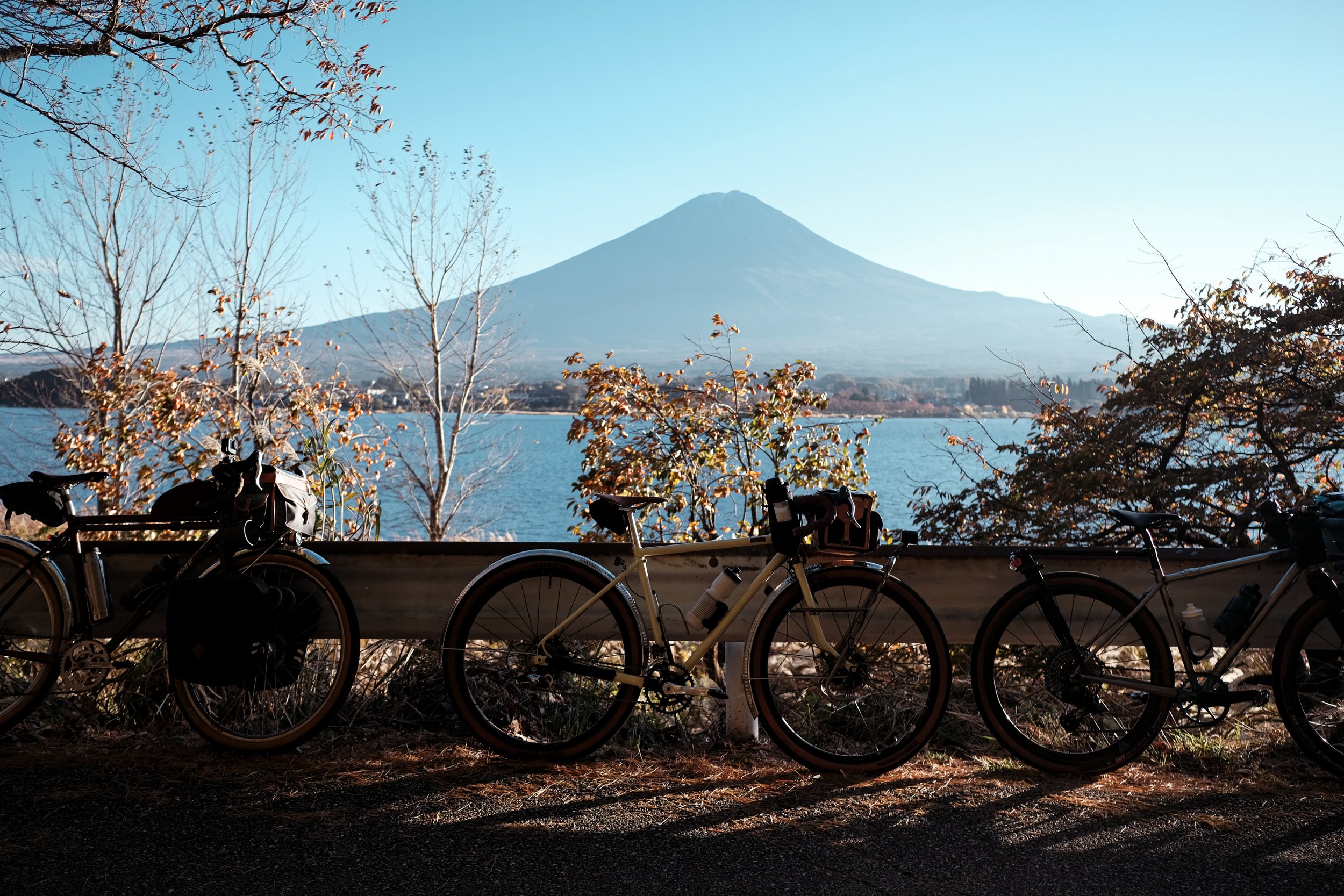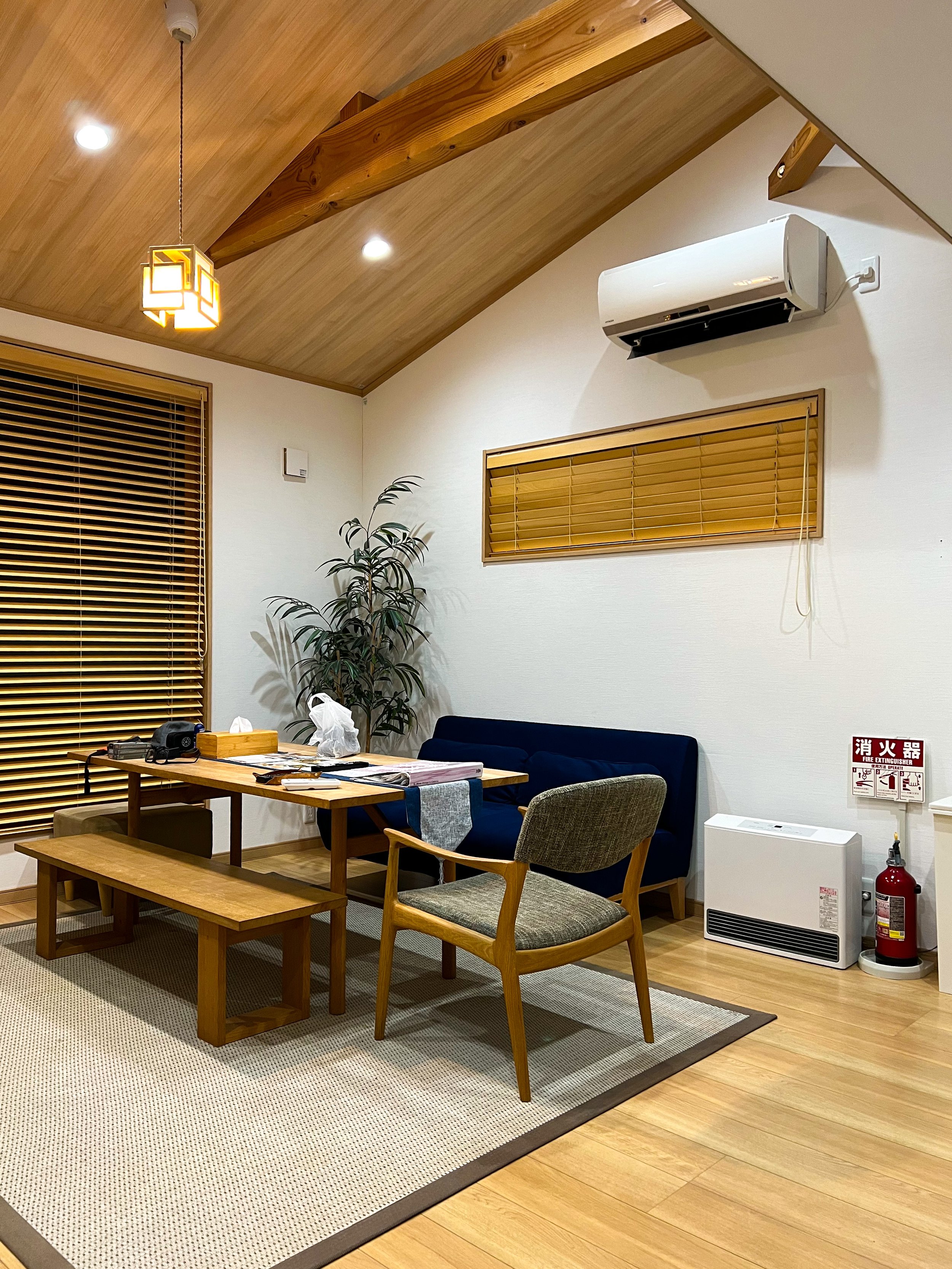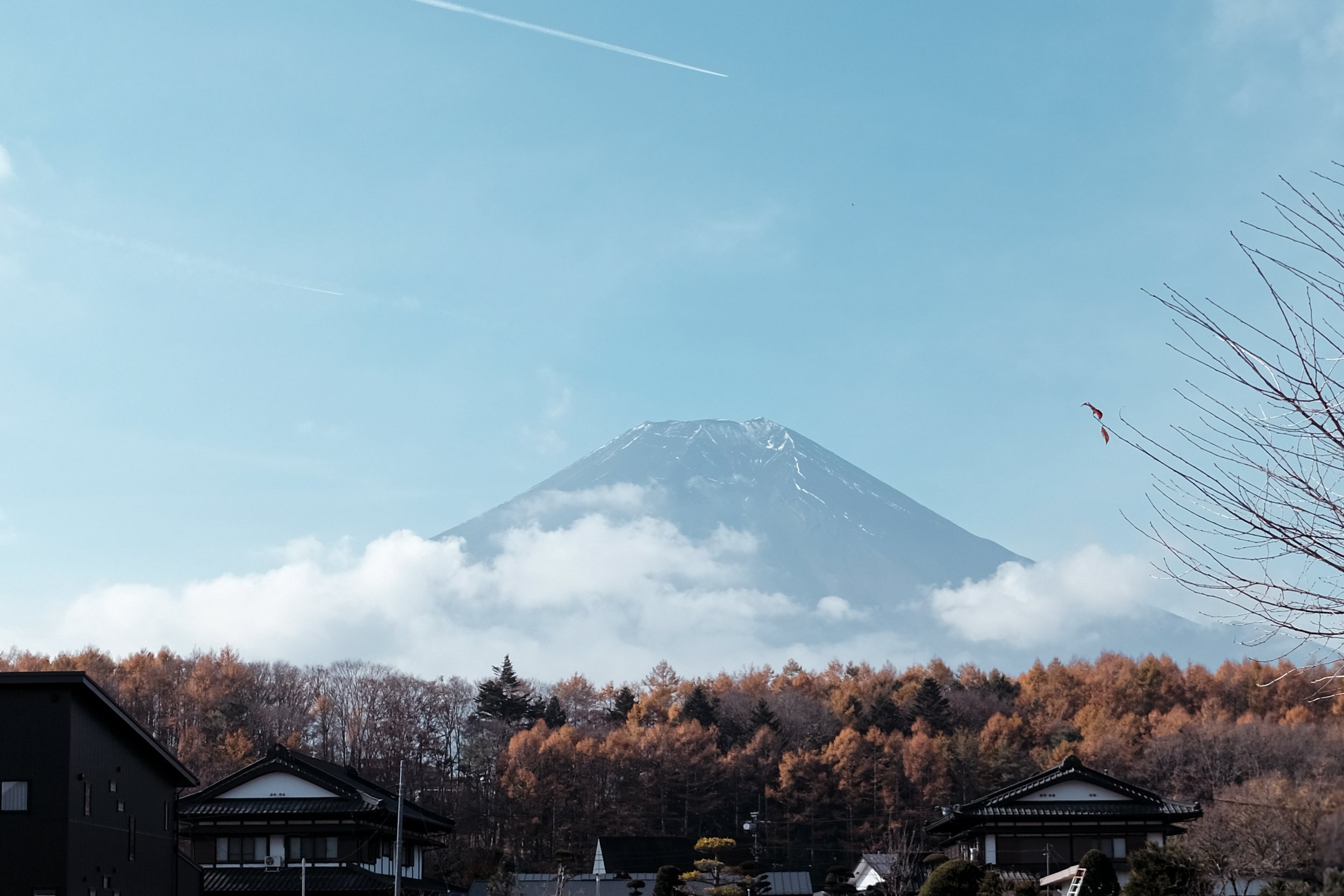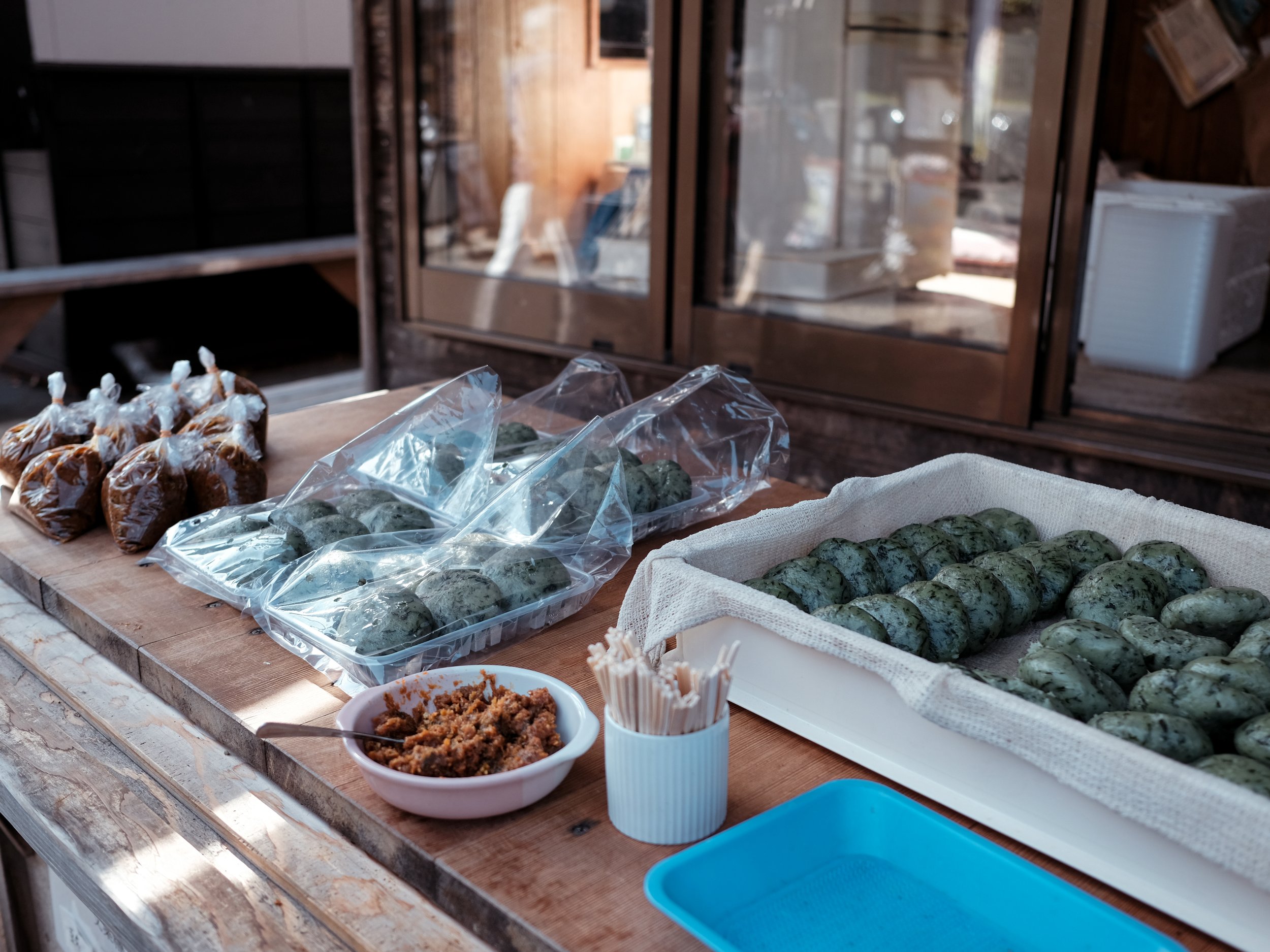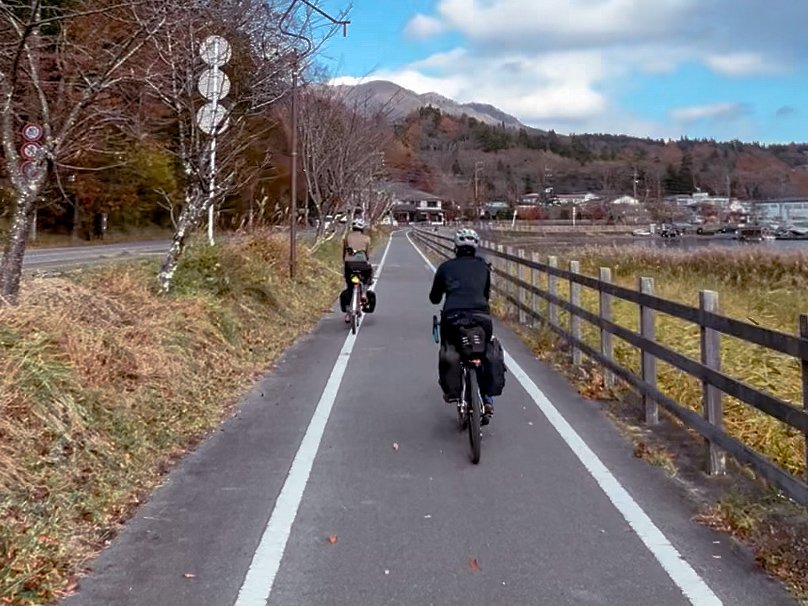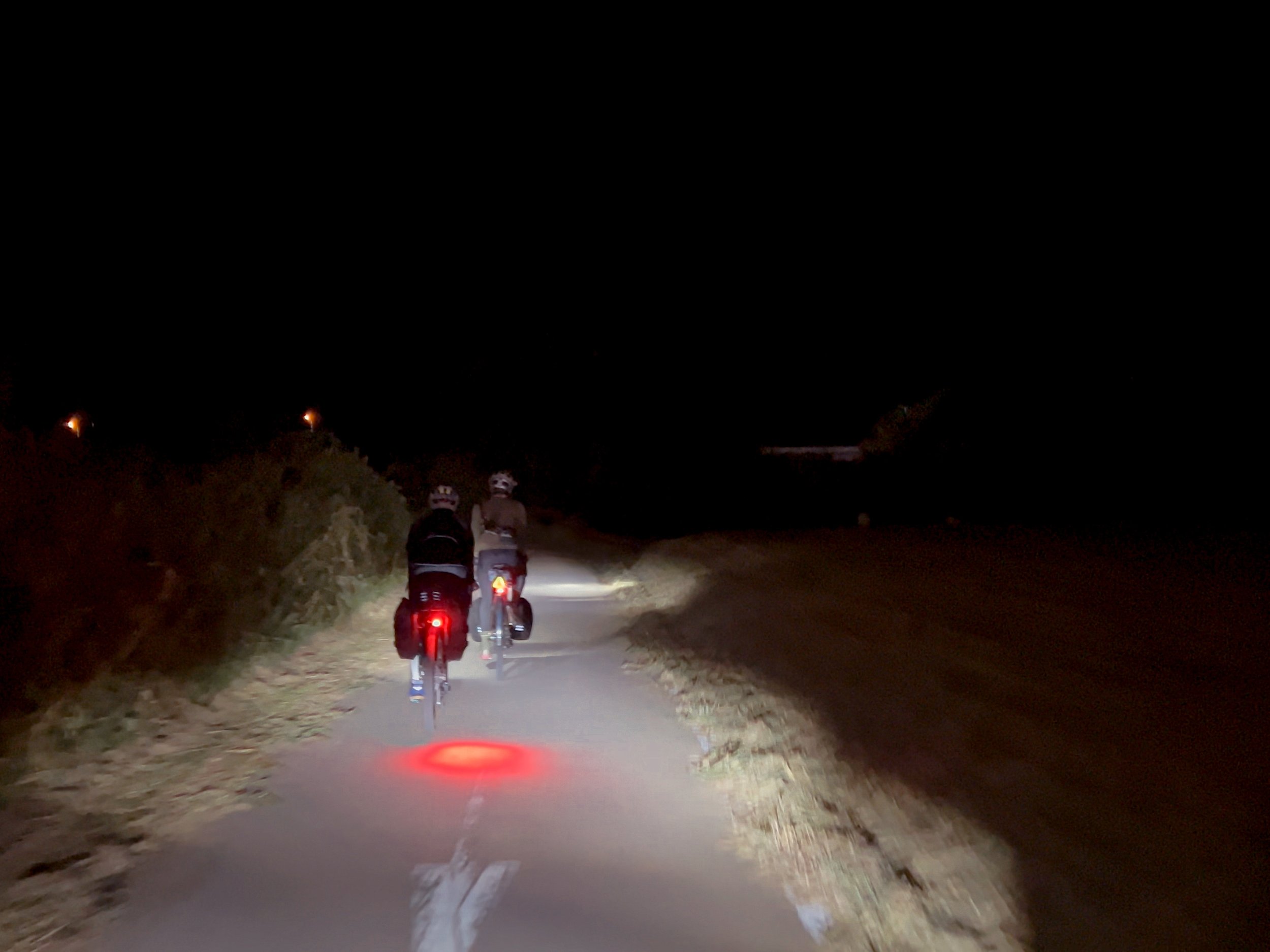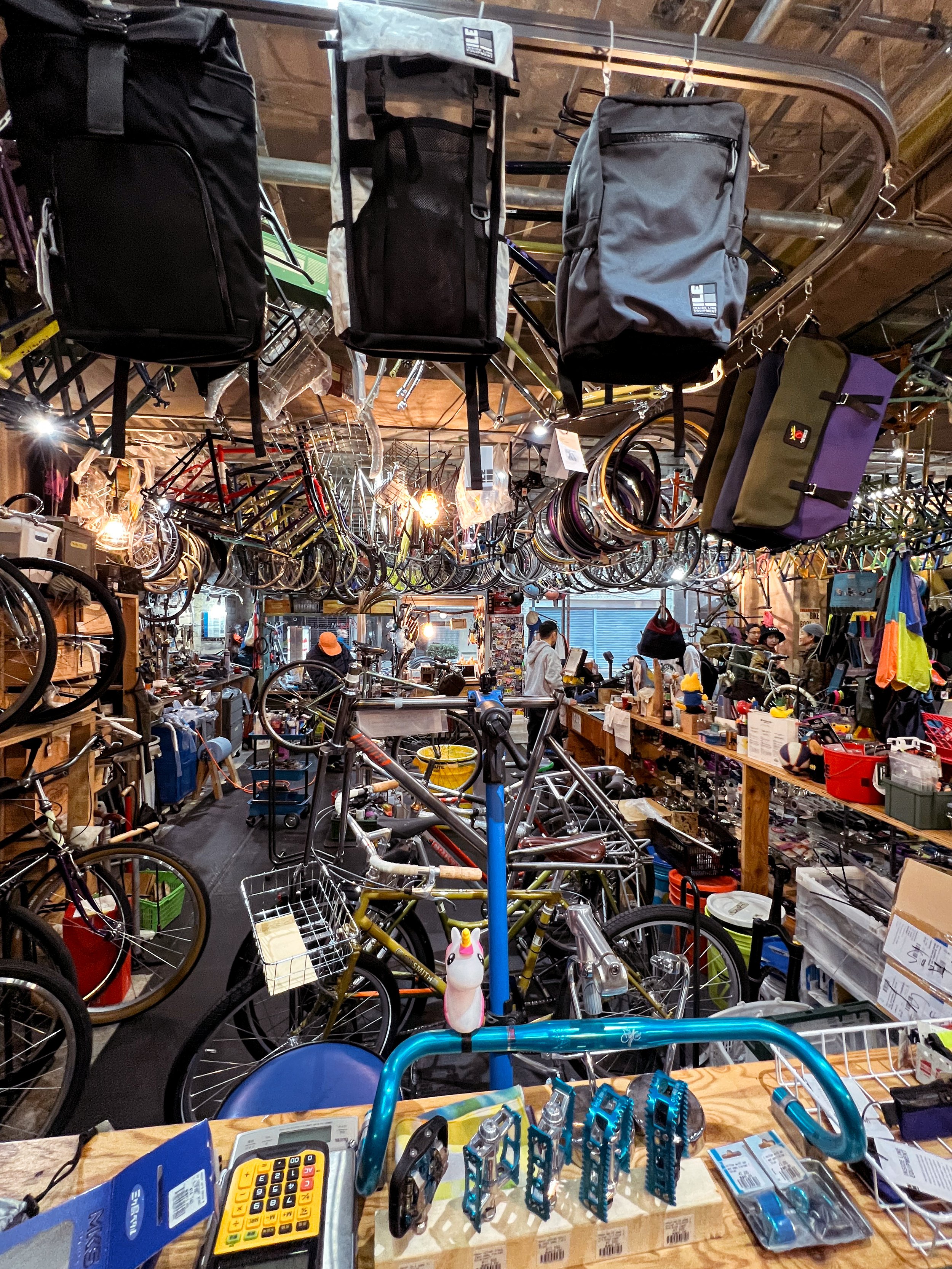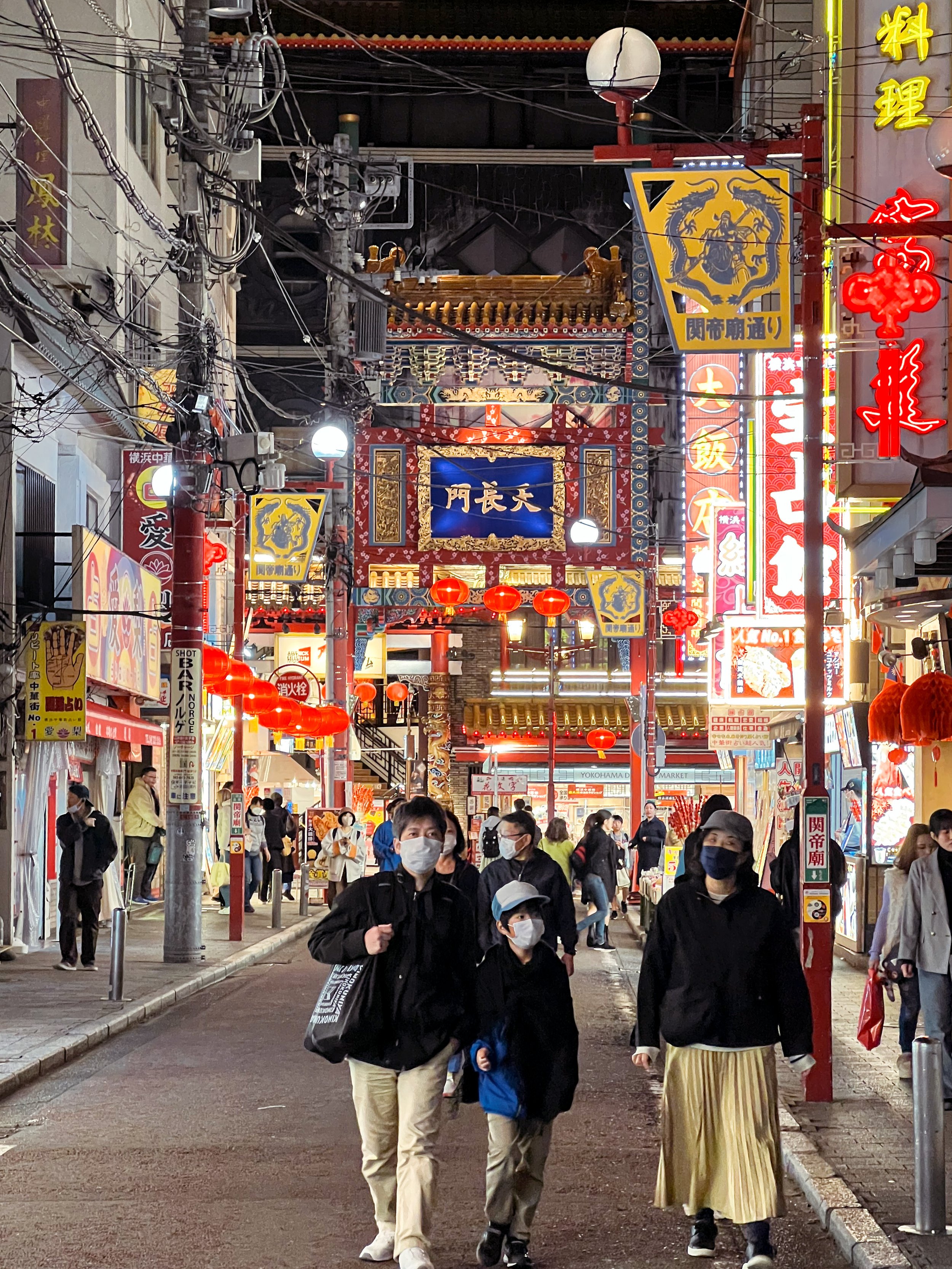Cycling Central Japan Part 4: Lake Kawaguchi, Kamakura, Yokohama
Lake Kawaguchi
Located in the town of Fujikawaguchiko in southern Yamanashi Prefecture near Mount Fuji, Japan, Lake Kawaguchi is the second largest of the Fuji Five Lakes in terms of surface area, and the lowest in terms of elevation. It is probably the most popular of all the five lakes (Yamanaka, Kawaguchi, Saiko, Shōji and Motosu) due to its train and direct bus connections to Tokyo, which make it the most accessible. This means it gets pretty crowded with tourists during peak seasons, namely the hanami or cherry blossom viewing season in spring and the equally popular momiji season in autumn. Nearby attractions include the Fuji-Q Highland amusement park, numerous hot springs, the Kawawguchiko Music Forest, and several museums - including the Kubota Itchiku Museum, which displays kimonos created by the artist who revived the lost art of Tsujigahana silk dyeing, used to decorate elaborate kimono during the Muromachi Period from 1333 to 1573.
Considering we were there in time for the beautiful fall colours in early November, the larger Kawaguchiko area was fairly full of tourists hoping to catch a glimpse of one of Japan’s three sacred peaks - Mt Fuji. At 3,776m high, the country’s tallest volcano is a behemoth that can be seen miles away. However it isn’t always a certainty, unless you’re there on anything longer than a single day trip. The volcano is often covered by clouds or haze, depending on the weather or the time of day. Since it was unseasonably warm the brief time we were there, Mt Fuji was mostly visible, but it’s iconic snow cap had disappeared despite making a brief appearance several weeks before we arrived as the autumn weather got colder. Hard to believe we’d never seen Mt. Fuji before, despite almost a decade of annual visits to Japan.
For a better view of Mt Fuji at Lake Kawaguchi, one can head to the Mount Fuji Panoramic Ropeway, which ascends to an observation point near the summit of Mount Tenjo. However, thanks to the sheer number of tourists there on the day, a long line proved a fantastic deterrent for us, so we opted for a round the lake ride on our bicycles instead. It proved to be a splendid choice, as this gave us the opportunity to view Mt Fuji from different locations and in different light conditions of the day. Our favourite time was hands down golden hour, as the setting sun’s rays bathed the peak and the surrounding mountains in a warm amber glow. It was a surreal experience to finally see the volcano, which is a pilgrimage site even until today, with many temples and shrines on and around it.
STAGE 9: Lake Kawaguchi to Kamakura
Start Lake Kawaguchi
Finish Kamakura
Distance104km
Climbing 650m
Grade Medium/Hard
The penultimate stage of our tour would start with some punchy climbs out of Kawaguchi before a white knuckled downhill and ending with long flat stretches, but we were still wary of the day’s ride as it was the longest distance we’d be covering on this trip. After nearly two weeks, legs were tired and nerves were already frayed, and truth be told it would prove to be one of the most challenging days of the entire journey. We started off with a quick Family Mart snack to add to the breakfast we’d had at our Airbnb before setting out. It was finally a cold morning after a few days of warm weather, so we were all bundled up properly for the ride. Making our way south east, we began climbing before even hitting the 10km mark, with a steep 12% gradient to a small peak approaching Oshino Hakkai.
After a brief stop to reinflate a mysteriously deflated but not punctured tyre on Maya’s bike at the peak, we had a brief flat segment before reaching Oshino Hakkai, the midway point between Lake Kawaguchi and Lake Yamanaka, two of the five Fuji lakes. The small village of Oshino has a set of eight ponds, which were once a lake - the sixth Fuji lake before it dried out several centuries ago. The waters of the ponds come from the snow melt of Mt Fuji, and the crystal clear waters are teeming with the most amazing sweetfish and rainbow trout which made a fantastic teishoku lunch of grilled fish. Oshino Hakkai translates to “eight seas” in Japanese, referring to the eight ponds of the village.
We had more climbing to do before reaching Lake Yamanaka, so a grilled mochi dango made a perfect extra fuel up before we continued on our way. Upon reaching Lake Yamanaka we rode along the eastern shore of the lake before stopping for another snack at a lake side cafe, even though it was barely past lunch hour. We were headed for the Mikuni Pass after all, the mountain pass that straddles the three prefectures of Tokyo, Kanagawa, and Yamanashi. Halfway up the mountain pass road lies the panoramic observatory, a famous spot to view a Diamond Fuji, namely the sun rising out from the peak of Mt Fuji. After a brutal climb and a quick coffee outside session at the Tokyo 2020 Olympic commemorative marker, we then followed the Yamanashi stretch of the Olympic Cycling Road Race in reverse: a hairy 18% descent down into Oyama.
By the time we reached Matsuda we had gone past the halfway mark for the day, and into the flat part of the route, in time for an early dinner of piping hot tendon at a random eatery we stumbled across in town. After that we journey continued along some dark and bumpy riverside bike paths, and we assumed the remaining 35km coastal road from Odawara to our Airbnb in Kamakura would be easy. But since we were out of the mountain roads and within city limits, what was left was a mind numbing stretch of pedestrian bridges, zebra crossings, and ten thousand traffic lights that slowed us down more than any mountain climb ever would. Four painful hours of stop-and-go riding later, we finally reached our accommodation in Kamakura, the first time we’d ever completed a tour stage after midnight.
STAGE 10: Kamakura to Yokohama
Start Kamakura
Finish Yokohama
Distance 29km
Climbing 141m
Grade Medium/Hard
We woke up still somewhat exhausted, looking forward to a day of respite after almost two weeks of heavy climbing, but the universe had other plans. As our friend Mio arrived and we packed up to leave tiny raindrops started falling, the first sign that last stage of the tour would not be an easy or pleasant ride into our final destination in Yokohama. The pitter patter soon turned into a constant drizzle, and even our shoe covers would not be able to keep our feet dry from the rain and road spray. It was tough to enjoy the seaside views as we rode on the wet tarmac only an arm’s length away from passing cars, as Mio led us to a special restaurant she had earmarked for lunch.
We reached Tenshinan after a steep but short climb and right smack during lunch hour, thankfully managing to get a table despite the packed restaurant. Located in front of the Kencho-ji Temple, the restaurant is famous for Kenchin-jiru i.e. vegetable soup, a traditional Japanese soup that originates from Buddhist temples. The flavours are simple, allowing the natural taste of the vegetables to take centre stage. It also has a meditation room overlooking an inner garden for visitors to use, though no one is allowed to eat meals there. The warmth of the steaming soup was a real comfort to have on a wet ride, and a wonderful break from riding in the rain.
We continued riding northeast through several residential neighbourhoods, eventually coming across a Komeda Coffee two hours later that was another welcome respite from the drizzle. We promptly sat down for some hot beverages and dessert, lingering a bit longer than necessary since we knew the ride wouldn’t be a long one. We’d not seen Mio for several years of the pandemic since her last trip to Kuala Lumpur, so the conversation was good and so were the teatime snacks. Reluctantly we eventually left the cafe, riding further into the city as we inched closer to the evening rush hour accompanied by the continuous rain. Several thousand traffic lights later and weaving past traffic and buses, we eventually reached our hotel in Yokohama safely after dark but drenched to the bone and everything dripping wet from a whole day of rain and road spray.
Checking in, we headed to our respective rooms gratefully to get out of our wet cycling clothes and shower, changing finally into urban clothing, as Mio took the train home to clean up before joining us for dinner. The bikes were packed in rinko form and stashed in our rooms, which everyone was fine with after the end of a long and challenging journey. We weren’t saddle sore by any means, but it was truly nice to finally be out and about on foot in normal clothes. The night ended with a celebratory spread at Quays Pacific Grill, a fantastic restaurant that serves what they call “New American” cuisine with a wide variety of dishes using salmon and oysters from all over the world. We savoured the shared meal with a side of fantastic night-time views of the bay, and the splendid meal was a fitting end to the tour as is our annual custom at the end of any journey.
Yokohama & Tokyo
As I mentioned above, this was the final destination of the tour, where our bike cases awaited safely in the hold of the hotel. Like most of our tours, it was a bittersweet end to a challenging journey that traversed many miles and crossed many mountain passes (Eka’s doing, obviously). Once a marshy and remote fishing village with only 600 residents, Yokohama first began to gain national and worldwide recognition when it opened its first port in 1859. Although Kobe was the first port to open in 1853, Yokohama was the first to open the doors of mainland Japan to foreigners to live and trade there for the first time in over two centuries. Yokohama is today Japan's second-largest container port with strong ties to global trade, particularly with North America and Europe, supporting the country's automotive and machinery industries. As the capital and most populous city in Kanagawa Prefecture, Yokohama is the country’s second biggest city, part of the greater megalopolis of Tokyo, which is only a half an hour train journey away.
The city’s history has resulted in a bit of a cosmopolitan feel for the city, which is no surprise since it was where western fashion became more accepted, ice cream and beer were first produced there, and recreational sports were also introduced by foreign residents. Japan’s first English language newspaper the Japan Herald was published there in 1861, as well as several other national newspapers. We’ve been to a number of Japanese cities in the last ten years of almost annual visits to the country, and Yokohama is one of our most favourite, besides Hiroshima and Kanazawa. The city was mostly destroyed and rebuilt during the Great Kanto Earthquake in in 1923 and air raids during World War II, but there are still many things to see and do there. It holds a different charm than cities like Tokyo, Osaka or even Kyoto.
For our group, Yokohama was just a nice way to unwind after a cycling tour, a welcome break before we packed up and headed for home. After two weeks of a heavily regimented schedule, we’d left the remaining days free and easy so that we could decide on the fly where to go, what to see, where to eat and so on. Rest and relaxation was a high priority, so we left our bikes at the hotel to stretch our legs instead, the irony of which is not lost on me because we ended up walking infinitely more than we did in a single week in Malaysia. There were also several prerequisites of course, which included a visit to Bluelug in Tokyo for some bicycle-related shopping since we would not have to pay any shipping or taxes there. This has pretty much become an annual pilgrimage of sorts, in addition to the actual cycling tour itself. Some camping goods shopping was also in order, before we were due to meet up with Mio again for another dinner.
But Yokohama was the home of the Gundam Factory (now closed T_T) so we figured it would be now or never to see the 18-metre tall moving RX-78F00 Gundam right outside the building. Off we went to the Yamashita Pier, only to find out belatedly that we were several hours too late and the exhibit had already closed for the day. All we got was a glimpse of the Gundam’s feet from the gate, meaning we will have to head to Osaka to see it since the factory has closed its doors and the Gundam moved there. It is now unfortunately only a stationary statue built for the Gundam Next Future Pavilion at Expo 2025. Disappointed, we trudged off to dinner with Mio, taking a stroll through Yokohama’s Chinatown, Japan's largest and most colorful. Mio had planned a special meal of Monjayaki, a not so well known dish similar to Okonomiyaki that calls the Kanto region its home, specifically the Tsukishima district of Tokyo.
Just like Okonomiyaki, Monjayaki is a type of savoury pan fried batter pancake which dates back to Japan’s Edo Period. However, Monjayaki goes back to the early 19th century and only evolved in the in the twentieth century from a children’s snack into a proper meal with a large variety of ingredients. Choose your toppings that will be spread across the hot iron plate; these will be sautéed and arranged into a doughnut shape before the thin batter is poured into the well in the centre. Everything is then mixed up and then topped with green onions and Worcester sauce. Needless to say, it was a fun night spreading the raw monja around the hot plate and eating it directly from the grill with small spatulas once it has caramelised into lovely crispy bits. The dinner would ultimately be the highlight of our time in Yokohama. As for the other things to see and do there, I suppose they will have to wait for our next visit.
Head to Cycling Central Japan Part 3: Kiso Fukushima, Matsumoto, Nirasaki, Lake Kawaguchi for the third instalment of this series. If you missed the beginning of the tour, you can go back to the starting point at Part 1: Kanazawa to Shirakawa-go or Part 2: Shirakawa-go to Kiso Fukushima.

